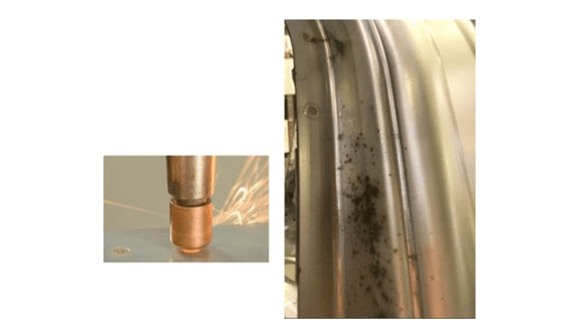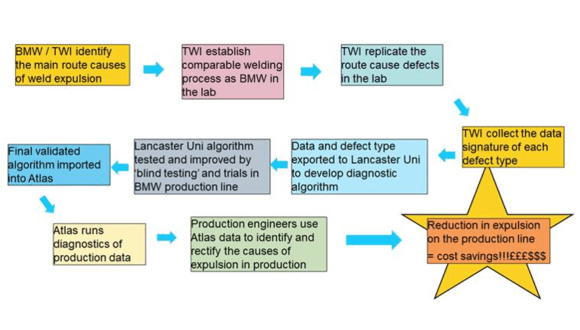Thu, 29 September, 2022
The Innovate UK-funded WeldZero project has closed following two years of developing intelligent robotic welding system solutions within a cyber-physical production system (CPPS).
This will aid international competitiveness for the UK as it modernises industrial capabilities to steer industry towards the wider adoption of automation and autonomous manufacturing solutions. These solutions would lead to improvements in accuracy, precision, quality, and manufacturing costs.
TWI were involved in supporting BMW Mini Plant Oxford in reducing instances of weld expulsion during resistance spot welding processes used for Mini bodies. Each of these vehicles contains over 6000 resistance spot welds that can potentially be subject to weld expulsion, which is when a physical instability in the welding process causes the ejection of liquid metal from the weld. While this expulsion is not often related to the production of a defective weld, manual identification and cleaning is required. The expelled metal can damage paintwork and initiate later corrosion failure leading to costs not only related to personnel being employed to rectify expulsion damage but also in corrosion warrantee claims.
Data collection at BMW is able to identify when and where expulsion occurs on the 1000+ robot production line, but not the reason why. It was important to determine the cause of expulsion in each individual case order to take steps to prevent it.
 Figure 1. Weld expulsion and visible damage to the vehicle body panels resulting from expulsion
Figure 1. Weld expulsion and visible damage to the vehicle body panels resulting from expulsion
TWI and BMW performed a study of production processes to identify the main causes of expulsion in resistance spot welding. These processes were then replicated in a TWI laboratory, using a similar robot and welding gun with the same weld timer, electrodes, tip dressers and welding programs. This allowed TWI to simulate and study production and collect data about instances of expulsion.
This data was then exported to Lancaster University where it was used to develop and train a diagnostic algorithm to identify the defects that cause expulsion events. This algorithm was then tested with blind data sets to test if it could determine the cause of defects from the data. These tests showed a success rate of >90% with lab data.
Finally, this laboratory data and algorithm were tested in a production environment at BMW Oxford with the help of ATS, who embedded the predictive algorithm in their Atlas software so as to analyse data fed from the BMW production line.
 Figure 2. Overview of the trajectory to develop a diagnostic algorithm to identify the root cause of expulsion in BMW’s production line
Figure 2. Overview of the trajectory to develop a diagnostic algorithm to identify the root cause of expulsion in BMW’s production line
This work showcases the benefits of digital technologies when applied to welding operations in an industrial manufacturing context to support a zero defect strategy and help improve UK competitiveness through the wider adoption of Industry 4.0 strategies.
The WeldZero Project has received funding from Innovate UK under No 105812